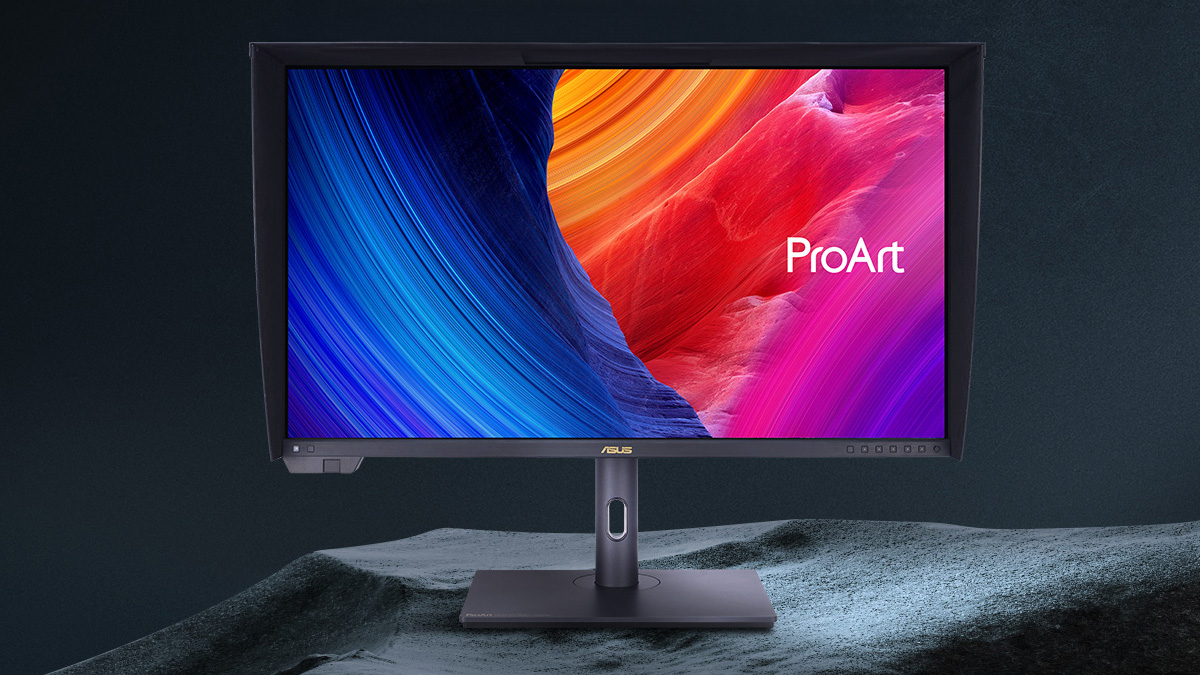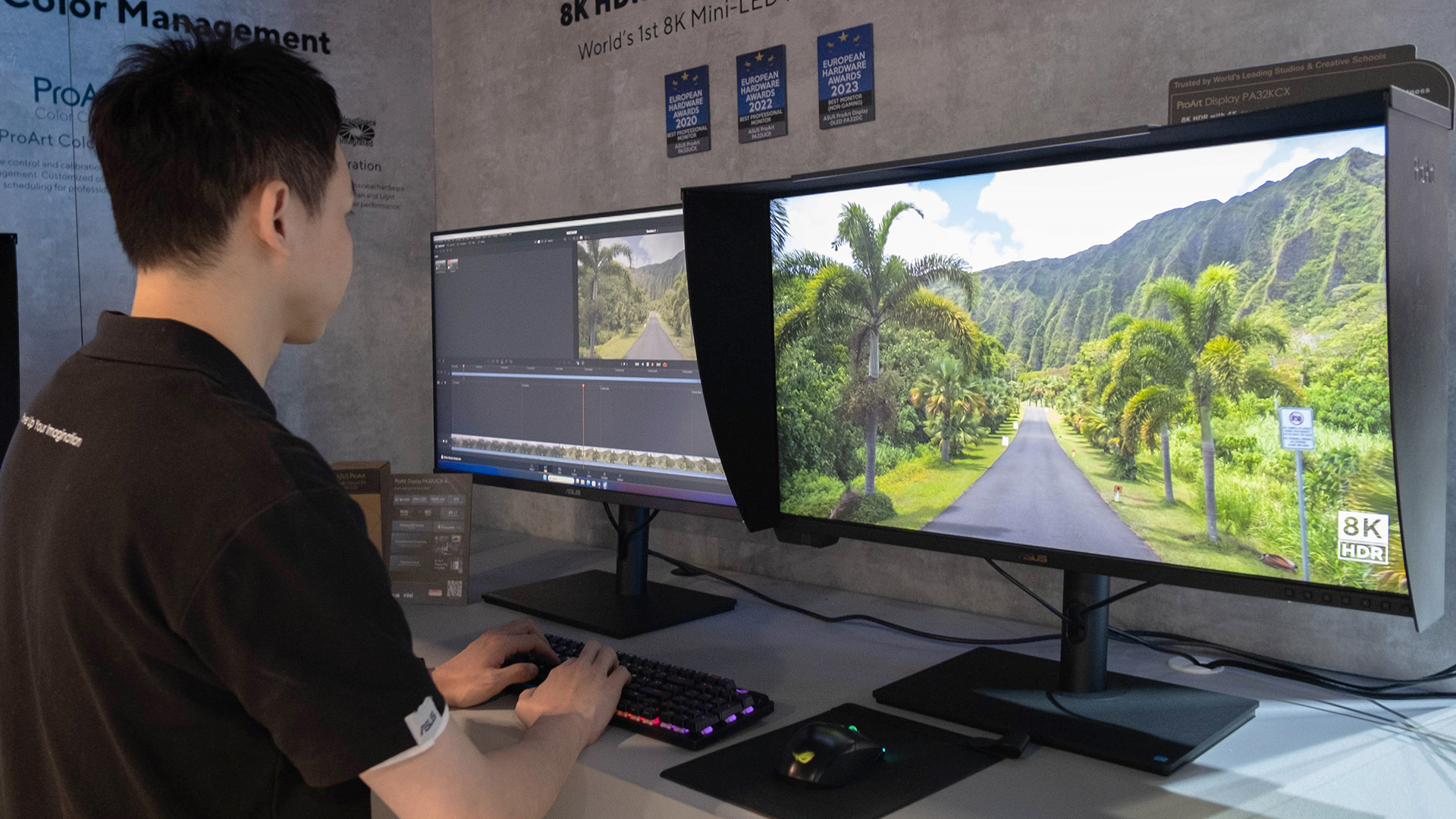Asus' 8K Mini LED ProArt display is the king of new ultra high-end professional monitors — 1200 nits and 4096 lighting zones
Mini-LED finally makes it to the ultra-high-end professional monitor market

Asus has unveiled a brand new 8K monitor for professional workflows dubbed the ProArt PA32KCX. It is the world's first 8K professional monitor with Mini LED technology, enabling the panel to display near-OLED-like black levels. The PA32KCX comes in a 32-inch form factor and features 10-bit color capabilities, with built-in self-calibration functionality. Display brightness peaks at 1200 nits. Pricing was not announced, but expect this new display to be priced well into the thousands of dollars.
The monitor specs include a pixel-dense 7680 x 4320 panel (275 PPI) that covers 97% of the cinema-grade DCI-P3 color gamut. The monitor comes with Asus ProArt hardware calibration tech to provide color-accuracy optimization and color profile write-back. Calibration can be done manually or automatically by the display itself. The monitor also comes with a built-in motorized flip colorimeter, making it easy to check and maintain the monitor's color accuracy over long-term use.
Thanks to the mini LED tech, the PA32KCX comes with a whopping 4096 backlight zones. Peak brightness is rated at 1200 nits which is more luminous than the 1000 nits of HDR10. HDR compatibility includes multiple HDR meta formats, including HLG and HDR10, enabling creators to check their HDR content for different target displays.
The PA32KCX also comes with all of Asus' eye comfort technologies including an anti-glare finish, low-reflection tech, and Eye-Care+ (which includes a flicker-free backlight). All these technologies aim to reduce eye strain and improve comfort levels during long work (or play) sessions.
The PA32KCX features DisplayPort 2.1 and HDMI 2.1 video inputs, as well as dual Thunderbolt 4 USB Type-C ports with up to 96W of power — perfect for running Asus' new ProArt display off of Thunderbolt 4-equipped laptops.
On paper, Asus' PA32KCX looks like it could be the best display on the market for tasks other than gaming. Its combination of mini-LED tech, cinema-grade color accuracy, 1200 nit peak brightness, and 8K resolution should give it very similar performance to some of the best OLED displays and TVs on the market. And of particular importance for a professional user who might want to use their expensive monitor for a decade or more, it achieves all of its performance without the risk of OLED burn-in thanks to mini-LED.
Get Tom's Hardware's best news and in-depth reviews, straight to your inbox.

Aaron Klotz is a contributing writer for Tom’s Hardware, covering news related to computer hardware such as CPUs, and graphics cards.
-
Reply
Pricing was not announced, but expect this new display to be priced well into the thousands of dollars.
Most likely around $8K USD !? 😲
1779907492715073833View: https://twitter.com/Vincent_Teoh/status/1779907492715073833 -
DougMcC Lighting zones are 90 pixels on a side. That's pretty terrible. I'd probably be happy enough with 5x5 or maybe even 9x9 but 90x90? No thanks.Reply -
peachpuff Reply
Show me a screen with 9x9 lighting zone.DougMcC said:Lighting zones are 90 pixels on a side. That's pretty terrible. I'd probably be happy enough with 5x5 or maybe even 9x9 but 90x90? No thanks. -
UnforcedERROR Reply
Dimming zone density is far less important than the processor control. The Sony X95L, probably the best mini-LED TV, only has 480 at an 85" screen size. The TCL QM8 has 2300 at 85", by comparison, and practically 0 blooming.DougMcC said:Lighting zones are 90 pixels on a side. That's pretty terrible. I'd probably be happy enough with 5x5 or maybe even 9x9 but 90x90? No thanks.
No one's putting 4K+ zones into a 32" form factor. If the processing is good you'll never see those zones (though HDR on PC is questionable). -
DougMcC Reply
That's fine for tv viewing. But this is a supposedly 'pro' monitor.UnforcedERROR said:Dimming zone density is far less important than the processor control. The Sony X95L, probably the best mini-LED TV, only has 480 at an 85" screen size. The TCL QM8 has 2300 at 85", by comparison, and practically 0 blooming.
No one's putting 4K+ zones into a 32" form factor. If the processing is good you'll never see those zones (though HDR on PC is questionable). -
DougMcC Reply
All the OLED monitors that bypass this problem completely.peachpuff said:Show me a screen with 9x9 lighting zone. -
peachpuff Reply
You're so smrt... you didn't mention oled in the original post, now please answer the question.DougMcC said:All the OLED monitors that bypass this problem completely. -
UnforcedERROR Reply
It's perfectly fine for content creation. It's better than "pro" monitors that are edge-lit, and it won't have an issue with burn-in, unlike OLED (and the peak brightness is way above most OLED). OLED is better because of per-pixel activation, but that's it.DougMcC said:That's fine for tv viewing. But this is a supposedly 'pro' monitor.
As someone who uses pro monitors for color critical work, I'd gladly take this over an OLED. -
vanadiel007 I don't know about this. You can buy an OLED monitor and replace it under warranty every year, and still be cheaper off 10 years down the road compared to this monitor.Reply
Most come with 3 year warranty against burn-in these days.
Unless you absolutely need an 8K 32 inch display, I see very little market share for this considering the price point it will have. -
dk382 Reply
There are no 32" 8K OLED monitors, so this point is moot. If you want that level of pixel density, then you need to use LCD for now. And if you want some level of HDR capability with LCD, then you need a mini-LED backlight. And there aren't any backlights denser than 4000 zones at 32" to my knowledge. Would it be better if the backlight were even denser, or if this used some kind of panel with self-emissive pixels? Of course, but that technology doesn't currently exist, so here we are.DougMcC said:All the OLED monitors that bypass this problem completely.
This much is obvious, isn't it? This is not a product aimed at general consumers. It's a professional monitor that will be sold to companies and studios with very specific use cases in mind (e.g. the mastering of 8K or XR content). It's not aiming for market share.vanadiel007 said:Unless you absolutely need an 8K 32 inch display, I see very little market share for this considering the price point it will have.
P.S. I'm pretty sure Vincent (from the tweet linked above) was joking about the price being $8K. Though we can expect a price in the thousands of dollars.
